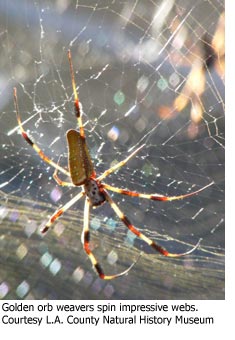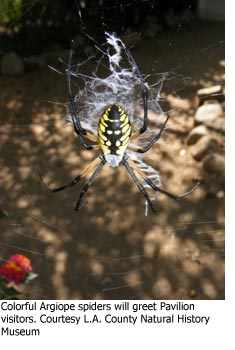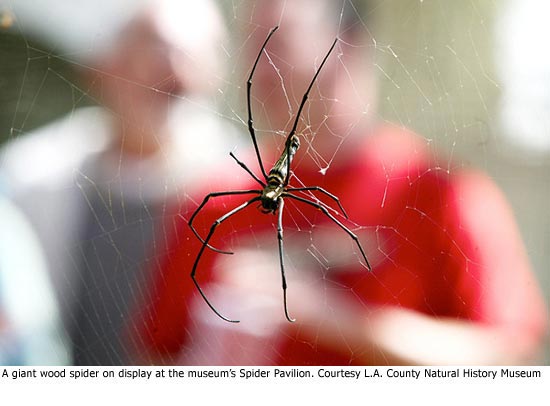Now here’s a special kind of web site
October 5, 2010
Arachnophobes, you can skip this story.
For the rest of you, the Natural History Museum’s annual Spider Pavilion is set to open September 26. The six-week exhibition features hundreds of spiders inside the long greenhouse on the lawn outside the museum.
But when it comes to spider season, the museum knows no bounds—including your backyard. Once again, museum scientists are asking the public to participate in its “Spider Survey.”
The survey was launched in 2001 as one of the community science projects the museum uses to engage the public in gathering scientific information about Los Angeles’ ecosystem. Over the years, the museum has received 5,000 specimens from citizen entomologists, who’ve mailed or hand-delivered spiders they’ve found around their homes or schools.
 Along the way, a few rarities have been discovered, including the dangerous brown widow spider, which is native to South Africa but was first found locally by a survey participant in Torrance. Los Angeles is a hotspot for such exotic species, says entomology curator Brian Brown, because they sometimes hitch rides on cargo coming into L.A.’s ports.
Along the way, a few rarities have been discovered, including the dangerous brown widow spider, which is native to South Africa but was first found locally by a survey participant in Torrance. Los Angeles is a hotspot for such exotic species, says entomology curator Brian Brown, because they sometimes hitch rides on cargo coming into L.A.’s ports.
(If you’re new to the survey, click here for a how-to guide from the Natural History Museum.)
This year’s survey comes with a new request to spider hunters. Brown and his team are asking volunteers to create “pitfall traps” to capture “micro spiders” that have been overlooked in past surveys.
Although the museum plans to post detailed instructions on its website in the days ahead, the basic idea is to bury a plastic cup up to its lip and then pour in a little anti-freeze to immobilize unsuspecting itsy-bitsy spiders that fall inside—spiders that are nearly impossible to see, let alone capture by hand.
“It’s quite possible we can find some species that are new to science,” Brown says.
Beyond the potential of scoring new kinds of spiders, the goal of the survey and the pavilion is to teach visitors how beneficial and harmless these creatures actually are, according to the pavilion’s creator, Brent Karner, manager of invertebrate living collections, who’s popularly known as “Brent the Bug Guy.”
Dealing with human fears and mistaken beliefs about spiders is a big part of the project, Karner said. Inside the airy greenhouse-like pavilion visitors can get up close and personal with the giant wood spider from Malaysia, as well as two species of spiny-backed spiders from the Southeast U.S.
 “I’m surprised at the number of people who say they have a very strong fear of spiders but who come anyway so they can work to overcome it,” says Karner, adding that full-blown arachnophobia is actually pretty rare. A mild to medium fear of spiders is common, with adults tending to be more scared than kids.
“I’m surprised at the number of people who say they have a very strong fear of spiders but who come anyway so they can work to overcome it,” says Karner, adding that full-blown arachnophobia is actually pretty rare. A mild to medium fear of spiders is common, with adults tending to be more scared than kids.
The Spider Pavilion is replacing the summer exhibit Butterfly Pavilion, a transition that represents a circle-of-life moment as the old tenants give way to the new.
“The butterflies are being eaten as we speak,” Karner said rather scientifically.
Tickets for the exhibition are included with museum admission. For those, who just want to see the pavilion, the rate is reduced—$3 for adults, $2 for seniors and students and $1 for children ages 5-12.
Posted 9/16/10















 405 bridge work causes a stink
405 bridge work causes a stink